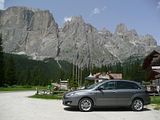

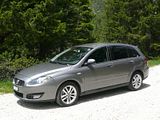
The Croma had a big hurdle to overcome. Probably an unfair hurdle. My day had started badly, with an unexpected arrival in my hotel room, without even knocking, at 7:15am from “housekeeping” who had to come to check the mini-bar (it turned out that everyone had experienced this unwelcome early visit!), and having had days of gorgeous weather, the forecast was for storms, so I was not in the best of humours when I arrived at the Hertz desk in Zurich airport to collect the car that was to take me to the Dolomites for four days of vacation. Despite having been assured that I would get, if not the car I really wanted, something agreeable, I was treated very rudely by an overbearing Hertz counter rep who told me in no uncertain terms that this Croma was the car I was having, and there was no choice. Period.
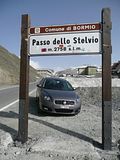
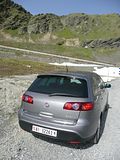
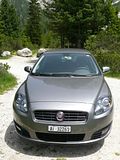
I set off, and my initial misgivings were, of course, unfounded. I’d driven a Croma last year. That was the 2.2 litre petrol engined car, and it had largely impressed me as sort of unassuming big comfortable machine. Now I had the chance to test out the 1.9 diesel, in the facelifted model, but – and this was why I was so against the car – equipped with an automatic gearbox. On the autobahn out of Zurich, heading south, the Croma immediately came into its own as a comfortable cruiser. The cursed diesel rattle, so evident on start up, and at lower speeds all but disappears, and once you exceed 110 km/h, the transmission very smoothly selects 6th gear, the revs drop to almost improbably low levels, and the car put me at ease in heading to my destination, Bolzano, some 350km to the south. However, once I came off the autobahn, and headed for the first Alpine Pass, my misgivings turned into frustration, and then utter disbelief. The combination of the very smooth but slightly lazy feeling automatic transmission, coupled with the turbo diesel engine with a very narrow band of torque meant that maintaining momentum became a real challenge. Alpine Passes are hard work in a manual, but you know that, and they can be fun. Here the difficulty was as you slow for the tight hairpin the car simply loses speed which it then cannot quite work out how to react to when you try desperately to accelerate away, uphill. The last diesel automatic I drove, an A6 2.0TDI had impressed me, but I do wonder whether it would have been any better in these conditions, or whether these configured cars are simply no good for this type of driving. There is actually ample power, and once you get to the right point in the rev range, enough torque that you can move up the hills far faster than any Dutch plated car seemed to be capable of doing. The problem was simply getting to that point. The dieselness of the noise from the engine was also ever-present whenever you did it. Not a particularly pleasant noise, either. There is an option to shift up and down yourself, with a simple nudge forwards or backwards of the lever once you have pushed it to the left. This did not make much difference. There was an audible buzzer which stopped you from trying to shift up until it thought you should, and falling foul of this a few times revealed that 4th, 5th and 6th are indeed all high geared. Left to its own devices, the transmission did sometimes rather jerkily shift, especially on slight engine braking when coming down a hill. I ended up concluding that the gearbox is the real weak point of this car and with a manual, I would probably have been far less critical. The upside of a diesel is, of course, better fuel economy. In 780km of driving, so far, at lot of which has been on punishing mountain roads, I have averaged 36 mpg. Not brilliant, but doubtless far better than the petrol model would have achieved.
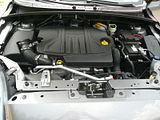
A large, heavy front wheel drive car like the Croma is never likely to be the first word in handling prowess, and indeed it is not. I had already discovered on some of the more swooping, but less steep roads that it does understeer a bit, and that it can roll quite significantly on corners. The steering is not endowed with the most feel, but it is far better than many recent offerings on the market. On the positive side, the brakes are excellent. They certainly took quite a punishing, with ascents of the Umbrail, ascents and descents of the Stelvio included on the outbound journey, and a day around the main passes in the Dolomites. One benefit of the long wheelbase is that the car rides quite well, too. Inside the cabin, there is also a mixture of good and bad. The good is that the quality of trim and fittings, and even the plastics, is about the best ever seen in a Fiat. Not up to Audi standards, for sure, but certainly on a par with Toyota and the Koreans, and perfectly acceptable. The bad starts with the fact that several of the things you operate are just that bit awkward. This starts with the seat adjustment lever. Buried under one side of the seat, it has a rather bulky plastic moulding to cover what is often just a simple metal bar. The handbrake – thankfully still a proper central pull up lever – is quite short, as the rear part of it is enclosed in the moulding that provides a very deep (but awkward to open) central cubby. There is a centrally mounted slot for the quasi-key, which is actually OK, but you have to have your foot firmly on the brake pedal for the car to start. All of these are minor irritations, but nonetheless, there are plenty of cars that have no such list! The interior of the Croma does not appear to have changed as a result of the facelift. Since this car is a lesser trim than my last one, there is no fake wood surround to the central console area, but a sort of plastic version of brushed aluminium, which actually looks better in my opinion. The dash is clear, though the speedo only has marking in odd multiples of 10, which makes judging 60 or 80 km/h a bit more challenging. There are some nice touches, too. I liked the fact that the intermittent wipers react to the rain sensor – coping with a downpour of biblical proportions that engulfed the car when I was between Merano and Bolzano.

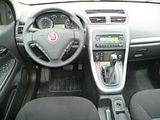
The real raison d’etre of this car is its roominess, and here it cannot be faulted. As well as being quite long, it is also tall. This means that there is a vast amount of space in the back seats, and there is a very capacious boot. Under the floor leveller, there is a further quite deep area. Surprisingly for a practical car, though, the rear seat cushion does not raise, so the backrests simply fold onto the cushion, leaving an upward sloping extended luggage area. Not ideal. The seats themselves are supremely comfortable, as I found out spending many hours sitting in them in the past couple of days, and they are covered in rather pleasant sort of velour material.
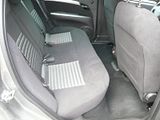
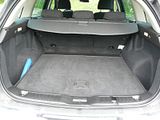
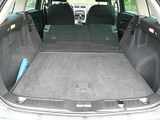
The Croma was facelifted late last year, with a new front end which has a very strong family resemblance to the Grande Punto and the Bravo. Indeed, seen head on, at a glance the Bravo and Croma are quite hard to tell apart. There were a few other tweaks – new badges, in line with the latest Fiat corporate style, and the boot model moniker badge appears to have been moved from the left of the tailgate to the right. Why?! Although the car did not sell well in the UK, it appears to sell in reasonable numbers in Europe, especially in its native Italy. Like many of the upper medium models these days, the absence of a premium badge means that demand will remain confined to those for whom lower purchase price is an overriding requirement. That seems to be an ever smaller number of buyers these days, and with the improvements in the quality of the Korean manufacturers, the squeeze will come ever harder for people like Fiat. In a way, that’s a shame, as the Croma is quite an agreeable car, just so long as you do not take it anywhere near mountain passes.
























